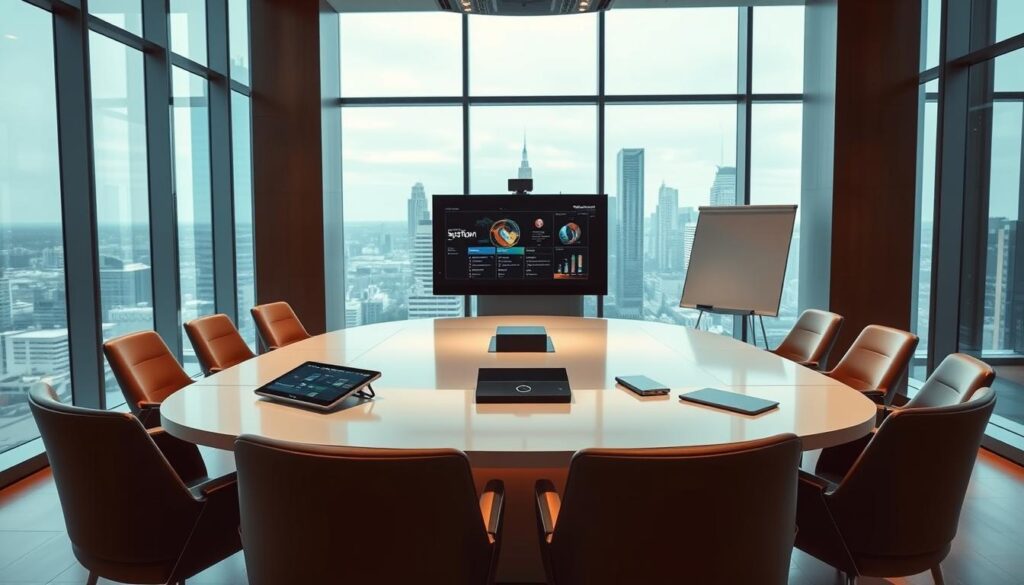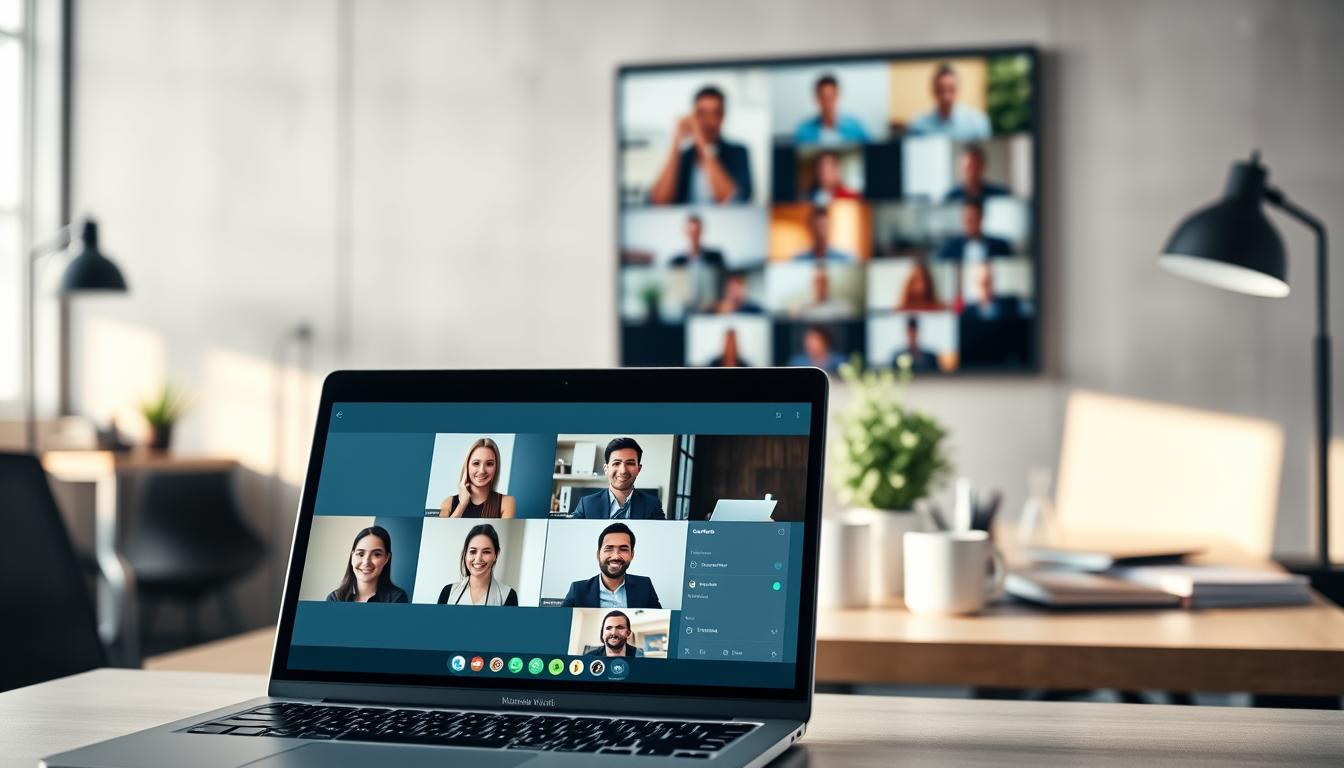In today’s fast-moving business world, making meeting schedules better is key. Ineffective meetings waste time and resources. By making meeting agendas more focused, companies can make every meeting matter.
This piece looks at ways to make meetings more productive. By setting clear goals and using the right tools, you can improve your business meetings. We will explore how technology and better communication can change meetings for the better.
The Importance of Optimizing Meeting Schedules
Effective meeting scheduling is key to boosting productivity within a company. When meetings are well-planned, they lead straight to useful results. These results help achieve company goals. Poorly planned meetings waste a lot of time and slow down success. By setting up meeting schedules better, teams can improve their work and how well they work together.
Maximizing Productivity
For businesses wanting top performance, making meetings productive is crucial. Good meetings keep discussions on point and create clear results. When teams have focused talks, the value of meetings shines. They help make smart choices. Planning meetings well means everyone can get ready in advance. This sets the stage for work to be done well and quickly.
Improving Team Collaboration
Optimizing meeting schedules also boosts teamwork. Making sure meetings are relevant and have the right people leads to better talks and idea sharing. This not only makes meetings more useful but also makes teams work better together. A smartly scheduled meeting fosters a space where everyone works better as a unit. It also prevents confusions among team members.
Defining Clear Objectives for Meetings
Setting clear objectives is key for successful meetings. They should do more than just bring people together. The aim is to meet with a purpose that helps achieve the company’s goals. This means having clear targets for each gathering, whether it’s making decisions or solving problems. This helps keep everyone focused.
Setting Specific Goals
Knowing what you want to achieve makes meetings more efficient. When people understand the goals, they can better prepare and contribute. Setting clear objectives guides the discussion, keeping it on the right track. To set these goals effectively, you can:
- Identify the main issue or decision needing resolution.
- Set measurable outcomes that indicate success.
- Ensure that the goals are presented in a way that motivates attendees.
Ensuring Relevance to Attendees
Making meetings relevant to those attending is crucial. It’s important that they see how the agenda relates to their role. When they understand the meeting’s value, they’re more likely to participate actively. To make sure attendees see the relevance, you can:
- Communicate how topics discussed tie into their daily work.
- Encourage input from all levels to create a shared ownership of results.
- Share pre-meeting information tailored to attendees’ interests and responsibilities.
Crafting a Focused Meeting Agenda
To make meetings work well, you’ve got to plan out the agenda carefully. A well-thought-out agenda keeps things organized and makes sure important points are discussed. By choosing the right items for the agenda, you help everyone stay on the same page and make meetings more valuable.
Elements of an Effective Agenda
What makes an agenda effective? It should have:
- Clear objectives for each discussion item.
- Allocated time slots for each topic to maintain pace.
- Designated speakers who will lead the discussion.
- Preparation requirements for attendees to come equipped with necessary information.
With these parts in place, your team can zero in on important matters. This avoids wasting time on off-topic discussions.
Distributing the Agenda in Advance
Sharing the agenda before the meeting is key. It lets everyone prepare better. When people come ready, it cuts down on confusion and boosts participation.
By reviewing the agenda early, participants can offer better input. This leads to richer conversations during the actual meeting.
Time Management Strategies for Meetings
Managing time well is key to making meetings productive and focused. The Eisenhower Matrix and the Pomodoro Technique are two main strategies that help. They offer different ways to manage time, making meetings more effective.
The Eisenhower Matrix Approach
The Eisenhower Matrix sorts tasks by how urgent and important they are. This helps meeting leaders focus on key issues first. It makes the agenda clearer and helps make decisions faster.
With this method, discussions stay on important topics. This stops less critical issues from taking over the meeting.
Implementing the Pomodoro Technique
The Pomodoro Technique uses short, intense work times followed by breaks. Applying this to meetings means adding quick pauses. These breaks help everyone stay focused and energized.
With this approach, meetings become dynamic and engaging. It helps create a more team-based atmosphere.
Effective Communication Techniques
For meetings to be successful, effective communication techniques are key. One crucial part is to prepare pre-meeting briefs well. These briefs make sure everyone knows what’s needed and the context before starting. This helps focus the discussion and saves time during the meeting.
Encouraging everyone to speak freely helps teamwork. When people feel safe to share ideas, creativity blooms. Such communication methods boost engagement and make meetings far more productive.
Utilizing Technology to Enhance Meeting Efficiency
In today’s work world, using meeting tech helps us do things faster and better. Tools like calendar and meeting management software make working together and staying on track easier. These tools are great for team collaboration.
Calendar Management Tools
Tools like Microsoft 365 and Google Calendar are key for planning. They let you easily work out meeting times with others. You get features like:
- Seamless integrations with other applications
- Automatic reminders for participants
- Color-coded events to distinguish between different types of meetings
These organization tools help make meetings more productive. With clearer schedules, everyone can focus better without worrying about conflicts.
Meeting Management Software Options
Software like Doodle and Trello make meeting planning better. They help teams work together in real-time and make everything clearer. With these tools, team members can:
- Vote on preferred meeting times
- Track progress on agenda items
- Share resources ahead of time
By using these software tools regularly, teams can keep meetings on point. This means better productivity and more engagement in meetings.

Delegate and Empower Team Members
Delegating tasks is key to making team members feel empowered. When leaders share tasks, it makes team members take responsibility. This makes team members feel important and trusted, which is critical for a strong team.
Building Trust Within the Team
Trust is vital for team success. Leaders show they believe in their team by delegating tasks. This boosts team members’ independence and promotes a transparent, respectful culture. Empowerment grows when people use their strengths to help the team.
Encouraging Team Participation
Getting everyone involved brings out new ideas and views. Encouraging participation makes room for creative solutions. When people feel they can share, teamwork and productivity get better. This openness is key for progress and reaching goals.
Optimize Meeting Schedule
Starting to optimize meetings means looking at how long they last. By studying these lengths, companies can spot patterns. These patterns help them plan better. Sometimes, short meetings work best. Other times, long talks are needed. This way, managing time gets easier, and everyone stays interested.
Analyzing Meeting Durations
Checking how long meetings last gives clues about team work. Often, a pattern shows if meetings drag on too long. Seeing these patterns helps teams:
- Figure out when to make some discussions shorter
- See which topics need more time for deep dives
- Keep meetings within planned times for better efficiency
Adjusting Based on Feedback
Asking participants what they think after meetings helps too. Quick surveys or chats give important info. People can say:
- If they think the meeting was too long or short
- Which topics needed more time or less
- How to make the meeting flow better
Using this feedback makes future meetings better. It’s a way to keep improving. It shows the company listens and wants to make things better.
Post-Meeting Follow-Up Strategies
Effective follow-ups after meetings are key to achieving real results. By summarizing important points and defining what needs to be done, everyone knows their tasks. This helps make sure team members are responsible for their roles.
Summary of Key Points and Action Items
It’s important to sum up each meeting with key decisions. Your follow-up should have:
- A recap of main topics.
- Tasks for specific team members.
- Deadlines for tasks.
This method makes sure everyone knows what’s expected and helps keep track of progress. It keeps the team working towards the same goals.
Encouraging Accountability
Setting clear tasks is crucial for turning discussions into actions. Regularly checking in helps maintain a sense of ownership. Here’s how to do it:
- Give each task a deadline.
- Have meetings to check on progress and talk about issues.
- Celebrate achievements to keep everyone motivated.
This creates commitment towards goals, boosting both individual and team performance.
Regular Reviews for Continuous Improvement
Regular reviews help teams get better over time. They look at what worked and what didn’t in past meetings. This lets teams improve their way of working, making things more efficient. It helps find what’s working well and what needs change.
Implementing Feedback Loops
Feedback loops are key for growth. Getting thoughts on meeting effectiveness makes future meetings better. This not only leads to improved meetings but also helps spot issues.
Identifying and Resolving Recurring Issues
Regular checks find ongoing problems affecting work flow. By looking closely at these issues, teams can fix them for smoother meetings. This practice doesn’t just address current problems but also promotes a focus on innovation and excellence.
Conclusion
Making meeting schedules better is key to improving how meetings work in any company. By setting clear goals, making detailed plans, and using modern tech, companies can make meetings more effective. This smart way of managing time helps create a teamwork atmosphere that pushes everyone towards the company’s aims.
It’s important to keep checking and getting feedback to make meeting processes better. Doing this helps build a place where every meeting matters and captures everyone’s interest. In the end, meetings become strong tools that help the company succeed.



